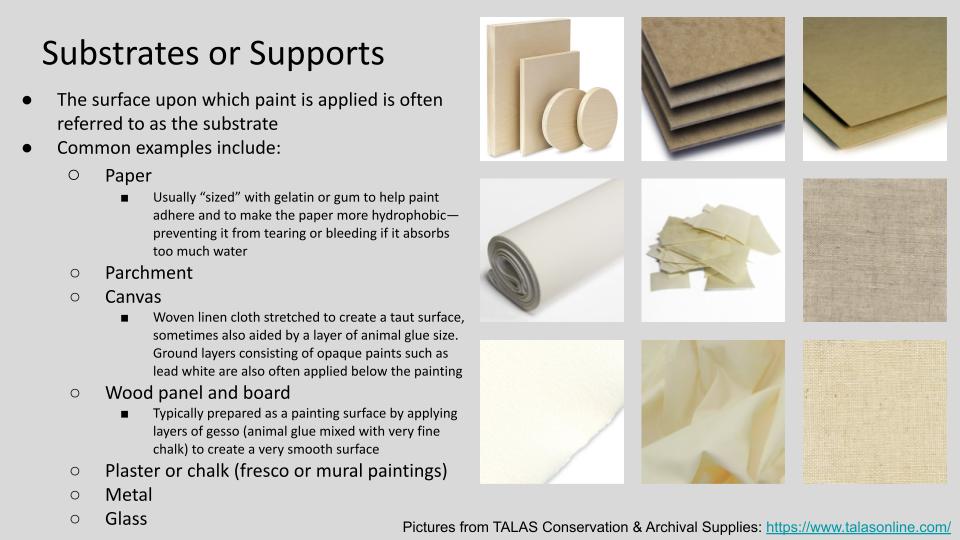Preparing Panels, Canvases, and Other Supports for Painting, Gilding, and More

 Images: Preparing a canvas for painting.
Images: Preparing a canvas for painting.
This activity teaches students how to prepare common supports, namely panels and canvases, to receive paint. The preparations outlined below ensure that any media applied to the support goes on evenly without risk of bleeding into or through that support. This activity can be undertaken as a stand-alone skill-building exercise or it can be a prelude to paint making and testing using hand-made lake pigments, hand-grown verdigris, and/or hand-levigated azurite. The Making and Knowing Project has found it useful to have various prepared panels and canvases on hand for other hands-on activities and experiments, such as applying metal leaf, varnish enamels, and metalpoint, and pounced designs.
 Images: Gessoing and scraping a panel for painting.
Images: Gessoing and scraping a panel for painting.
Learning Objectives
The activity of preparing supports has several potential learning outcomes, which can include:
- understand the behavior of wood and fiber supports under various conditions (e.g., wet/dry; slack/tension)
- understand how intermediary layers help isolate paint from absorptive supports
- exprience the time and effort required to complete under-acknowledged yet critical preparatory steps in the art-making process
- experience how support texture and ground layers affect the application and appearance of paint, metal, etc.
- gain an appreciation for unseen elements in a finished work of art
 Images: Preparing paper for metalpoint. Right: Metalpoint portrait by Rogier van der Weyden © The Trustees of the British Museum (CC BY-NC-SA 4.0).
Images: Preparing paper for metalpoint. Right: Metalpoint portrait by Rogier van der Weyden © The Trustees of the British Museum (CC BY-NC-SA 4.0).
Supports, Substrates, Surfaces, and Grounds
The terms “support” and “substrate” are often used interchangeably to mean the material structure or backing to which art media are applied. For instance, canvas, panel, plaster, paper, metal, and glass are all supports. The support itself provides a surface for the application of media (e.g., canvas for the application of oil paint), but in its raw state, a given surface might be unsuitable (e.g., raw canvas can have a coarse texture; it is absorbant, so wet media bleeds and spreads). It is common to apply ground layers to a support so that it gains an even and impermeable surface for the application of fine media such as paint, metal leaf, and resins. Common grounds include size (glue), gesso, wax, and bole. In some cases, colored grounds are applied to supports in order to help achieve a particular artistic effect. In general, some media adhere better to particular supports and grounds than to others.

Teaching Support Preparation
Preparing Supports: Presentations
Preparing Supports: Activity Sheets & Resources
- Classroom activity sheet for preparing gessoed test panels to receive paint samples [DOCX] [PDF]
- Classroom activity sheet for preparing canvas to receive paint [PDF]
- Handout: Historical recipes for metalpoint ground
- Field Notes: Rosenkranz & Uchacz, “Varnishes in the Rain, Part I: Canvas Preparation and Painting”
Follow-up Activities: Making Paint and Using Supports for Painting
- Lesson Plan: Making Paints from Pigments and Binding Media and Painting Them Out
- Presentation: Introduction to Pigments & Paints
- Classroom activity sheet for paint making [PDF]
- Presentation: Preparing to Paint and Painting in Distemper, Tempera, and Oil
- Presentation: Flower Painting in Oil According to Willem Beurs (1656-1700)
The Preparation of Supports in Ms. Fr. 640
Numerous entries in Ms. Fr. 640 address the preparation of supports for the application of various media. A non-exhaustive sampling includes:
- Canvas for painting in oil without breaking
- Painting in oil on taffeta
- For painting in oil on taffeta without the oil running
- Stretching a canvas picture
- Mending the cracks in a panel
- First whitening of a panel
- Grottos
- For gilding on wood
- Seat for gold
- Seat for gold leaf on parchment or paper
- Gilding molding for panels with or mat
- For coating it
- Cutters of printing plates
The author-practitioner mentions techniques for preparing supports in passing, as in the entries “Painter” on fol. 56v and “Drawing” on fol. 62r. There is no systematic way to catch all instances, so it is useful to search broadly. It is also useful to search the edition for particular supports such as “canvas,” “panel,” “parchment,” or “stucco,” techniques such as “gilding,” or terms such as “imprimatura,” “ground,” and “seat,” being mindful of homonyms and context.
There are also several essays in Secrets of Craft and Nature in Renaissance France that explore the use of various prepared supports, including:
- Marilyn Bowen and Tianhe Lou, “Painting in Oil on Taffeta Without the Oil Running.”
- Marilyn Bowen and Tianhe Lou, “Painting in Oil on Taffeta I.”
- Sumeyye Yar, “Painting in Oil on Taffeta II.”
- Lila Goldenberg, “Gilding on Paper and Parchment.”
- Njeri Ndungu, “What is Or Mat in Ms. Fr. 640?”
- Sahar Bostock, “Tablets.”
- Cleo Nisse, “Shadows Beneath the Skin: How to Paint Faces in Distemper.”